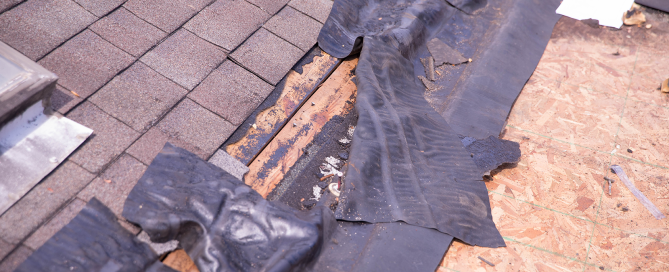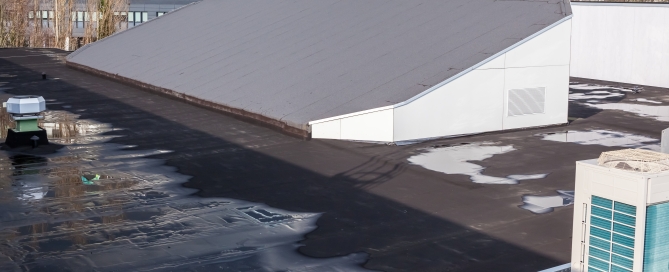Common Flat Roof Problems and How To Fix Them
Flat roofs are a popular design choice for modern buildings, offering a sleek, contemporary appearance and efficient use of space. They are often used for commercial buildings, residential homes, and even outdoor areas like rooftop gardens or terraces. However, despite their clean look and practical design, flat roofs have some common problems—problems that you can fix when you know what to do. Proper care and maintenance are essential to addressing these challenges and ensuring your roof’s longevity.
Ponding Water
Ponding water is one of the most frequent problems with flat roofs. Ponding happens when rainwater collects in puddles on the roof and fails to drain properly. Over time, standing water can weaken roofing materials, cause structural damage, and lead to leaks.
To fix ponding water, install additional drainage systems, such as scuppers or internal drains, to help water flow off the roof. Alternatively, you can use tapered insulation to create a slight slope, directing water toward the drains. Regular inspections can prevent long-term damage by identifying drainage issues early.

Leaks and Moisture Damage
Because flat roofs don’t have the natural runoff provided by sloped roofs, they are particularly prone to leaks. Moisture damage can lead to water stains, mold growth, and roof structure weakness.
To prevent leaks, use waterproof coatings, flashing tapes, a durable sealant, or other quality RoofKit Roofing repair products to close any gaps or cracks. For long-term solutions, invest in high-quality waterproofing materials. In addition, regularly inspect your roof, especially after heavy rain, to catch leaks before they become widespread problems.
Membrane Damage
The roofing membrane is a crucial component of flat roofs, acting as the primary barrier against water intrusion. However, it can sustain damage from debris, foot traffic, or extreme weather conditions. Tears, punctures, or general wear and tear on the membrane can compromise the roof’s waterproofing abilities.
You can repair minor damage by applying a sealing compound or patching the area with a compatible membrane material. For larger sections of damage, consider replacing the affected section entirely. Using protective walkways or mats can also minimize wear caused by frequent foot traffic.
Pooling Around HVAC Units
Many flat roofs house HVAC systems and other equipment, and water can pool around their bases. These pools can accelerate material degradation and increase the risk of leaks. Thankfully, you can resolve this issue by installing protective RoofKit Roofing flashing around the base of your HVAC unit to redirect water away from vulnerable areas. Additional drainage solutions, such as channels or scuppers, can also manage water accumulation and prevent pooling.
Clogged Drains
Blocked drains are a significant issue for flat roofs, as they prevent water from flowing off the surface. Debris such as leaves, dirt, or bird nests can clog drains, leading to water buildup and increased pressure on the roof. To prevent this, regularly clear debris from your roof and drains, especially after storms and in the fall. Installing drain covers or strainers can also reduce the likelihood of clogs.
Poor Installation
Improper installation is a leading cause of flat roof problems. Poorly installed membranes, flashing, or drainage systems can lead to leaks, structural damage, and premature wear and tear. If you suspect your roof was poorly installed, consult a professional to assess the work and recommend corrections or consider repairing or replacing your flat roof using quality RoofKit Roofing products.
Thermal Movement
Flat roofs are susceptible to a wide range of temperatures, causing roofing materials to expand and contract. Over time, thermal movement of some roofing systems can lead to cracks, splits, or weakened seams. Flexible roofing materials, such as EPDM, are a great choice to minimize damage and withstand temperature fluctuations. Regular inspections can also help you identify and repair thermal damage early.
Structural Weakness
As buildings age, they naturally settle or shift, putting stress on flat roofs. Shifting can lead to sagging, cracks, or other structural issues. To address structural weakness, reinforce areas showing signs of strain with additional supports or materials. Regular inspections by a structural engineer can ensure your roof remains safe and stable.

Aging Materials
All roofing materials have a lifespan, and even the best-maintained flat roofs will eventually show signs of aging. Cracks, leaks, and general wear are common indicators that your roof materials are nearing the end of their life. If your roof is showing extensive aging or repeated problems, it may be time for a complete replacement. Choose materials that offer improved durability and resistance to modern roofing challenges.
Flat roofs are a functional and stylish choice, but regular care is required to fix common flat roof problems. Whether you’re dealing with ponding water, leaks, or aging materials, taking proactive steps now will save you time, money, and stress in the future. Don’t wait—start protecting your flat roof today with RoofKit Roofing. With our high-quality flat roof roofing material, keeping your roof in top shape can be easy!




